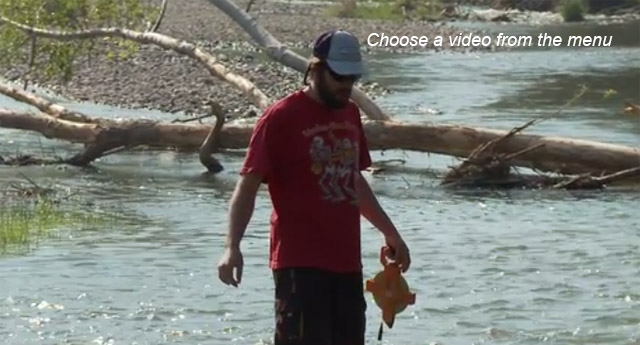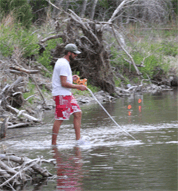Mike Booth
Creative problem solving with technology: Using new tools to study fish movement and behavior

Other Resources
Mike's Profile

1. What is the focus of your research?
I am fascinated, aesthetically and intellectually, with freshwater aquatic communities, particularly in the western deserts and mountains of North America. I am interested in examining how movement patterns can influence how species affect their ecosystems. Currently, I am investigating the ecological role of Desert and Sonoran suckers in streams of the Southwestern US. My current research suggests that the Sonoran Sucker (Catostomus insignis) has strong influences on the distribution and abundance of major resources (detritus, algae, invertebrates) in stream food webs, but the extent and importance of these effects are only now being discovered. Despite the fact that the Sonoran Sucker currently is one of the most abundant fish in the southwest, we know relatively little about its basic biology. My research integrates new technology to track fish movements (using automated fish detection systems) with field experiments measuring the effects of fish feeding on stream characteristics like water clarity and algae/invertebrate abundance. I have observed strong linkages between fish activity and water clarity, as well as the modification of the stream bottom as fish dig in the gravel and sand as they feed. In addition, my data suggest that suckers regularly move significant distances within the stream, implying that conservation efforts must preserve large sections of streams to be effective. Understanding the role this important species will provide a stronger impetus to properly manage and conserve the fishes of the southwest, not only for their inherent worth, but for the services they provide to their native habitats.
2. What got you interested in this line of research?
I first encountered the Desert and Sonoran suckers a few years before starting graduate school, helping some researchers with population estimates of fish in Aravaipa Creek, Arizona. Aravaipa is a particularly unique place, as it is the only stream in Arizona that still contains all its native fishes, and it is the most intensively studied stream in the southwest (at least in terms of the fish). Researchers were concerned, however, that native fishes might be displaced by exotic species, like smallmouth bass and bullhead. Despite regular population surveys in Aravaipa Creek, relatively little is know about the behavior and role that fish play in that ecosystem. The loss of native fishes would be tragic from a biodiversity perspective, but would it matter at all to other organisms in the ecosystem? Early in my dissertation research, I observed that algae was much less abundant when fish were present, and my experiments confirmed that fish grazing was influencing the algae. Since those observations, my research has followed the fish, trying to uncover in what ways and to what extent fish modified their ecosystem. I also observed that the fish seemed to move around—sites that had a few fish one day might not have any the next. Some new technology (PIT tags) allowed me to actually observe the movements of individual fish over long periods of time, adding a completely new dimension to my understanding of how fish might affect the stream.
3. Where did you grow up, and how does this relate to what you are doing now?
I grew up near Santa Cruz, California. I spent much of my childhood camping in the Sierra Nevada mountains, playing in tidepools at the beach, and hiking in the redwoods. I’ve always been fascinated with fish and fishing—I kept bluegill as pets for a while—and on bridges, I always stop and look for fish. In high school and college, I worked for Big Basin Redwoods State Park and volunteered with the Monterey Bay Salmon and Trout Project. Working in the outdoors and having opportunities to do research all over the world has encouraged me to pursue the research I do today.
4.What do you like to do in your spare time?
I build hollow wood surfboards and travel as much as I can to go shoot photos, surf, climb, and backpack. I love designing and fabricating things, anywhere from stereos to jewelry to graphics and websites. I strive to integrate science, art, and design to create a tangible product that is both beautiful and functional.
5. Why is it important for us to conserve biodiversity, and how does this relate to your career path?
We have little idea of the consequences of species loss in ecosystems, and may only find out when it is too late. Water is a limiting resource for life in the arid Southwest, where rivers and riparian corridors (vegetated areas bordering streams) provide essential resources (i.e., food and water) to the surrounding area and provide habitat for unique native aquatic organisms. Southwestern streams are threatened by a variety of human-induced changes. Perennial flows of many streams are reduced by population expansion and the increased groundwater pumping and land use changes this brings. The same factors that threaten the persistence of Southwestern streams have caused declines in native fishes. Unless steps are taken, fish populations will continue to decline, potentially with cascading effects on the rest of the stream ecosystem. In a variety of stream systems, fish that are abundant or have unique feeding habits may alter where and when resources are available within the stream, modifying the overall structure of the ecosystem. My research provides important information for people trying to manage threatened ecosystems, and potentially enables us to conserve more species.







